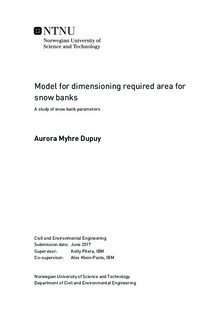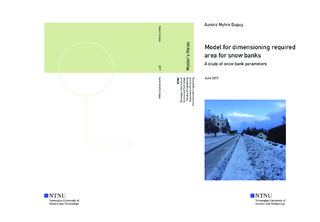| dc.description.abstract | After snow events, winter maintenance crews typically plow snow from the driving lanes to the side of the road, creating snow banks. Snow banks may impact cyclists and pedestrians as sidewalks are often used for temporary snow storage. In urban areas, where the space is limited, snow hauling is performed, which is expensive and time-consuming. Thus, it is desirable to limit the volume of hauled snow, but this requires increasing the width of the roadway to allow for more on-street snow storage. In order to understand the tradeoffs between hauling snow and increased roadway widths, it is necessary to model the area required for snow banks.
No existing snow bank models has been found in published literature during this research. The aim of this study is therefore to create a snow bank model that estimates the accumulated snow volume after mechanically handled, as well as the snow bank width. The roadway width, maximum snow bank height, new snowfall depths, existing snow depth on bare ground, and the density of newly plowed snow and compressed snow are input parameters to the model. There has been limited researches carried out regarding snow banks and their properties, but some studies performed on density in snow banks and -piles has been executed. Further dimensioning values for the new fallen snow and existing snow depths were found by analyzing data from the Norwegian weather portal seNorge.
A case study of Trondheim city, Norway was used to illustrate how the model works in practice. In addition, the case study will be used to compare the results from the model with the results from a sensitivity analysis.
The sensitivity analysis was performed on the input parameters of the model to determine their significance and evaluate the model. The parameters connected to the plowed width, maximum snow bank height and snow depth were identified as most significant for the model. Further, the densities of newly plowed snow and compacted snow were found to be of least significant, but these results contradict with the results from the case study.
A cost-effective analysis should in the future be included in the model in order to evaluate if adjusting the roadway width is lucrative compared to snow hauling during the entire lifetime of the road.
The model is intended for assisting road planners while designing roads. | |

